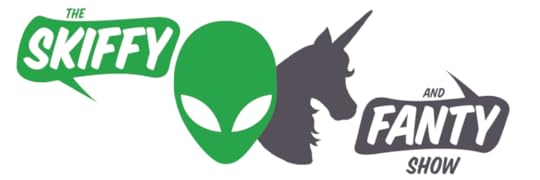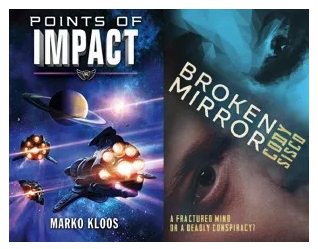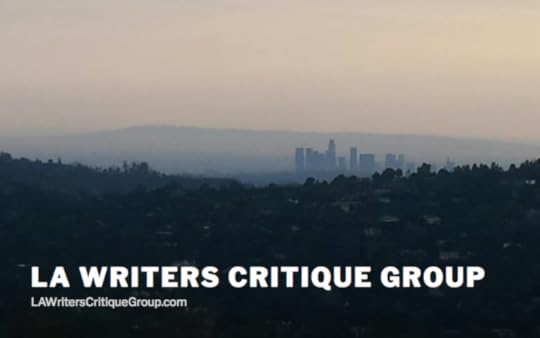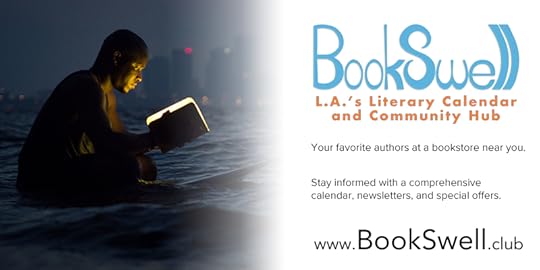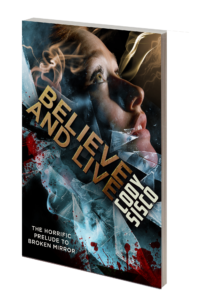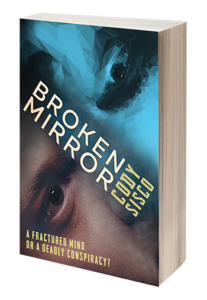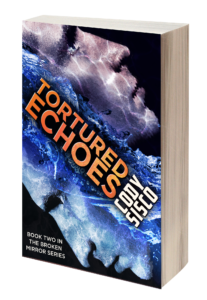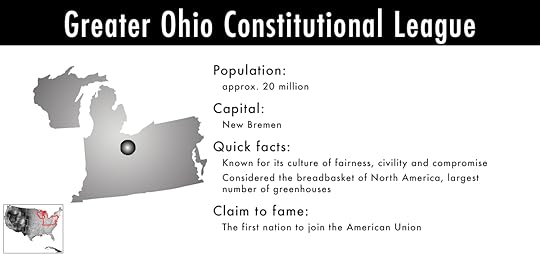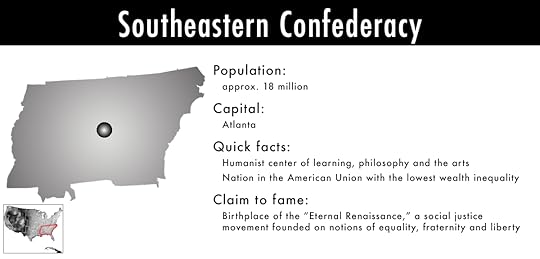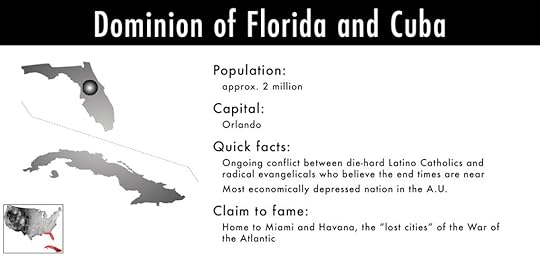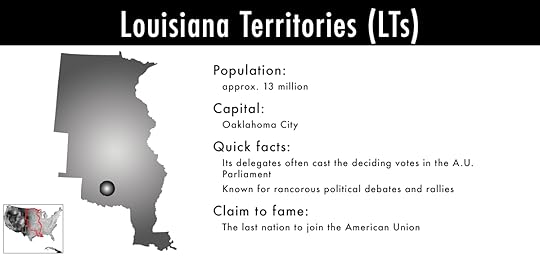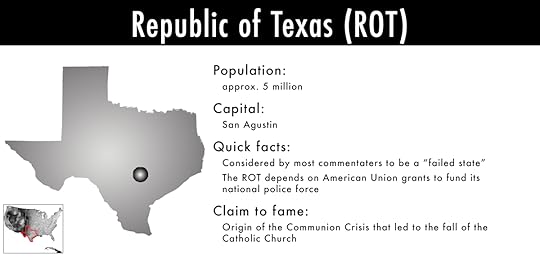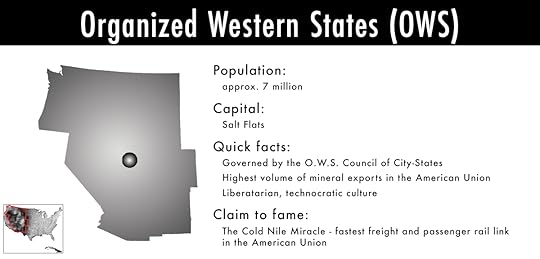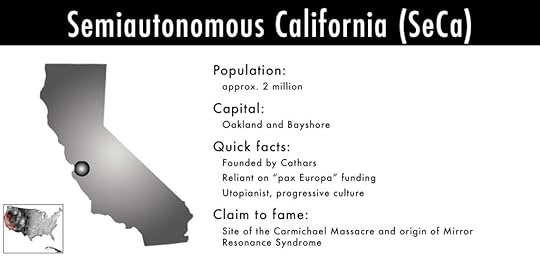Cody Sisco's Blog
October 1, 2025
Protected: The Resonant Earth Synopsis
This content is password protected. To view it please enter your password below:
Password:
December 16, 2024
On Queer Cyberpunk Alternate History
I’m going to introduce the Resonant Earth Series along three themes: 1) Queer, 2) Cyberpunk, and 3) Alternate History. But first, a bit of background on the main character and what’s going on with his brain…
I deliberately wrote about mental illness in a way that is both familiar and uncanny. I want readers to see some commonalities while simultaneously struggling with new concepts around medicalization and stigma.
This is from a Scientific American blog post headline: Mental Illness is Far More Common Than We Know. “New research suggests that nearly everyone will develop a psychological disorder at some point in their life—but for most, it’s temporary.”
For Victor Eastmore, the main character, his mental illness diagnosis is a prison, and he desperately wants to escape. Mirror resonance syndrome causes him to experience extreme emotional transference. He literally feels what other people feel. Mirror resonance syndrome is a neurodegenerative disease with a genetic origin. He suffers from “blank outs,” which is loss of memory, hallucinations, and vivid nightmares. He lives in Semiautonomous California, a nation where people with mirror resonance syndrome are monitored and institutionalized. Most become catatonic by their early 20’s. He is doing better than most, thanks to his family’s substantial resources. But every day is a struggle to cope.
Readers will probably notice a couple of things about Victor in the early chapters of Broken Mirror: his synesthesia, which is when one sense gets translated into another, like when you see musical notes as color or patterns in the air. Victor visualizes people’s emotions as colors and movements. They’ll also notice the stigma and prejudice he faces. One chapter includes a flashback to when he was bullied in middle school
What makes the Resonant Earth Series queer?First of all, on Resonant Earth, the default sexuality is bisexual, or what the characters call “duophilia.” Duo for two, and philia for attraction. Duophilia—meaning the characters like both genders, male and female. If I were to go back and rewrite the book, I might expand that to include multiple genders and/or a concept I just ran across two weeks ago called “gender-chill,” but duophilia is where my mind was when I started writing Broken Mirror in 2013.
Duophila is no big deal. Being the default. It’s not questioned. It’s not challenged. Characters can express attraction and act on it without raising any eyebrows. Gynophilia or androphilia, being attracted to women or men, respectively, is less common, but there’s no stigma, no persecution, no restriction of citizenship or rights based on gender and sexuality. This is part of why sometimes my novels are referred to as utopian.
This queer aspect is a sort of unobtrusive background for the story, especially Broken Mirror, because the main character is ace, asexual. He’s got no time or interest in sex, really, mainly because he’s preoccupied with trying to stay sane.
. So in terms of sensibility also, the book is very queer in that it’s written from a fringe point of view, from the perspective of an outsider, who at first tries to fit in and then decides that no, he’s going to be himself and it’s the world that has to change. And no, unfortunately, Victor and Ric don’t get together.
What makes the Resonant Earth Series cyberpunk?For one, I love writing about gadgets and how they change characters daily lives and philosophies about life. Self-driving cars, earbuds, and microphones allow people on Resonant Earth to access artificial intelligences, cybernetic implants, and an alternative to the Internet that doesn’t feature cute animal videos.
I ask readers what they like about the book to get a sense of what resonates. Very often they mention the Springboard Café, which is a hacker haven in the desert, as one of the scenes they remember. Victor and Elena go on to meet Victor’s old roommate, Ozie, who disappeared while they were still in college. Spoiler alert: there’s a bit of a sad love story there, but I won’t say more now.
But overall, Victor’s journey takes him into anti-corporate sabotage, theft, and proto-revolutionary directions. Meanwhile, he has to evade surveillance and work with street-level thugs and anarchists to deploy destabilizing technologies.
What makes the Resonant Earth Series alternate history?Finally we come to the alternate history piece, and this is a big one that I’ll only be able to touch on. The central idea behind my approach to alternate history is that we’re living in an accidental world. Accidental, yes, because a lot of history twists and turns on gambles and audacious propositions. There are several moments in my lifetime where I feel history turned in the wrong direction.
The history of Resonant Earth might seem utopic. After the Civil War, the Confederacy is not only subdued, but there is a sustained political and cultural transformation that sees women and former slaves lead a successful civil rights movement 100 years earlier than in our world. There’s no Jim Crow. There’s no KKK. A common motto throughout America becomes “skin is skin.” Racism has no place in society, not for individuals and not for the systems that govern them. Reparations are paid to both former slaves and native tribes. Racism is a choice. On Resonant Earth, they chose not to.
Also, on Resonant Earth, Abraham Lincoln survived the assassination attempt. Germany assembled a few key allies and won the First World War, enabling it to steadily gobble up all of Europe over the subsequent decades to become a superpower. The empires of China and Japan, locked in brutal, destructive combat for most of the century, lay waste to much of Asia and the Indian subcontinent. The United States, bankrupted by war, repartitioned into the nine sovreign nations of the American Union, one of which is Semiautonomous California.
If 9/11 was an event that transformed America, then the Carmichael Massacre is what transformed Semiautonomous California. Twenty years before the start of the Resonant Earth Series, a man named Samuel Miller went on a destructive rampage that destroyed Carmichael and cost hundreds of lives. One survivor lived through the nightmare and became a crusader for justice, which meant the creation of a Commission that cracked down on mirror resonance syndrome, which was thought to be a dangerous disorder.
The Resonant Earth Series is available wherever books are sold. I recommend The Resonant Earth Publishing Webstore or Bookshop.org.
October 22, 2024
Is Utopia a Dirty Word?
Originally published on Author Anthony Avina’s Blog.
In the world of Broken Mirror, cancer has been cured, civil rights for all citizens of the American Union of Nations are respected, and guns are strictly regulated everywhere. At first glance, I can see why you might think it’s a utopia. Indeed, librarians catalogued the book that way.
Cataloging is an interesting process. Publishers submit their data to wholesalers and retailers using standard categories. But librarians also have a say on how a book is categorized. It’s their expertise and their domain. So it was at first a surprise and then a delight, after the first edition of Broken Mirror was published in 2016 and I was looking up where the book was available at libraries across the country, when I discovered that it had been categorized under Utopias and Utopian Fiction, among other designations.
Fast forward to when I attended the American Library Association conference this year in San Diego. The convention center—the same one that hosts Comic Con—was filled with people who work with books in all kinds of ways. There were authors, publishers, artists, publicists, technologists, and of course librarians. The librarians who attended were looking for books to acquire but also for ideas and systems to help them run programs for their patrons, which vary from book collections and author talks to crafts, literacy courses, VR and technology hubs, and much more. In a way, libraries are the custodians of a utopian version of the future that is accessible, small-d democratic, and built on concepts of intellectual freedom, self-improvement, and community care.
However, I can understand how readers might have some qualms about calling my book a utopia. First, it’s too dark. Kirkus Reviews wrote that “the world and the characters work together to effectively form a cohesive story about how easy it is for society to classify a group of people as dangerous outsiders.” Juliana Caro reviewed the book for Reedsy and called it “a breathtaking, deeply dark alternate-history Earth with complex characters, layered worldbuilding, and twist after twist after twist.” Bleak, right?
The other problem with calling Broken Mirror a utopian book is that, when I try out the phrase, I get too many blank stares in response. Everyone is very clued in to what a dystopia is: the end of the world, things changing in unsettling ways, dark powers controlling things in secret. There are some elements of this in my book, but they’re balanced by those nice things like everyone enjoying civil rights.
The story is also definitely not about a false utopia, where things appear great on the surface, but danger lurks beneath the surface. The dangers in my book are part of the premise and they are front and center on purpose. We are familiar with false utopias through tropes introduced to the popular imagination by Twilight Zone, Star Trek, and many others, such as The Truman Show, Black Mirror, WandaVision, etc. But I’ve always been writing what I see as a realistic and balanced story about how our present could be if we made different choices throughout our history.
It’s important to note that a utopia is not a place where everything is perfect. It’s a thought experiment that imagines different structures and forces, sometimes hidden, sometimes plain as day, that shape society.
I’m coming to terms with the label of utopian fiction. Resonant Earth imagines an alternate history of Reconstruction after the U.S. Civil War being successful. In other words, formerly enslaved people gain full citizenship and civil rights. Women were a key part of the abolitionist movement, so I also imagined that they won the right to vote and full participation in civic life and the economy. Imagine if America could wake itself from all its awful, destructive, and painful -isms by the turn of the century (and by that I mean 1900). What kind of world would we live in today?
It’s very easy to become pessimistic about the future of humanity. Global conflict, biosphere degradation, the simply terrifying physics of climate change—who is going to save the world from such calamities? The answer is that each of us as individuals can come together to implement solutions. If I can’t live in utopia, at least I can write about one, live there in my imagination, and bring that creativity and resolve back into the real world.
Interview about Broken Mirror by Love Bytes
Originally published by Love Bytes LGBTQ Book Reviews.
What was your first published work? Tell me a little about it.
Oh, wow, it was a short poem titled “Modern Love” about how scary sex could be as a young gay man during the HIV/AIDS crisis. There’s a line I wrote that is so “baby gay poet” it makes me smile. Something like “love is hiding in a condom.” It was the early days of the world wide web, and NYU was publishing poetry and essays about the health crisis online. It’s a marvel that they’re all still there. http://cvisions.cat.nyu.edu/dwa/galle...
What was the inspiration for Broken Mirror?
A few ingredients combined to create the framework for this saga. I remember being on a train, travelling to and from Paris to a small town in Switzerland for a work meeting. The trip was around five hours each way. As I looked out the window, I was reflecting on how different my life was from most people’s. Half a world away from home, I was fretting over corporate purchasing policies and sustainability metrics, while the Alps rushed past, and then I was looking at really wild and colorful graffiti as the train approached Basel.
How had this become my life?
I got to thinking about a character that evolves beyond their upbringing and innate biology and wondering how far I could push the idea. Could a character accumulate so many bizarre and transformative experiences and modify their biology and mind to become something more than human? How would they relate to their friends and family and where they had come from?
That was the core of Victor Eastmore—isolated but trying to connect. The mental illness and family dynamics accumulated from there.
He actually started out as a pretty middle-class kind of guy. Then I shared a very rough draft with a dear friend who was living in London and working on a book about anti-terrorism tactics in Saudi Arabia. He’s always been a deeply spiritual thinker. We had long conversations about the manuscript and my intentions that steered Victor toward being from an elite family that symbolized the successes and failings of the political and economic systems. And those systems are threatened by his quest for the truth.
So, on the one hand, you have Victor coming from an elite family with all the resources and privileges that go along with that, but he’s also stigmatized, harassed, and victimized for having a mental illness that government policy and social norms say makes him the lowest of the low in the social hierarchy. For that part, I drew on some unfortunate and painful family history with mental illness and institutionalization. We really fail the most vulnerable among us and criminalize people who need medical and psychiatric help. I’m writing against that model while investigating the complicated and contentious issues around mental healthcare.
What were your goals and intentions in this book, and how well do you feel you achieved them?
I knew I had three big challenges ahead of me as I was writing this book. First, it takes place in an alternate history world so I needed to bring the history into the story in smooth and natural way. Second, the story is a murder mystery so I had to lace in clues and twists. Third, and perhaps most challenging, I had to write from the perspective of a character with a mental illness that should feel familiar and realistic, but also vivid and uncanny, and create a strong bond and empathy between the character and readers.
There were also additional aspects that got polished in the revised second edition. I wanted to bring out the queer elements and make them shine a bit more so. The new version has more trans and nonbinary characters, polyamory, same-sex attraction, and makes things that were subtext more explicit. I worked on pacing a lot in the revision and made the leap toward non-linear storytelling.
Maybe the next book I write should be less ambitious. [laughing] No, I like a big challenge.
Tell us something we don’t know about your heroes. What makes them tick?
Victor knows in his core that he’s being treated unfairly by the medical establishment and the government of Semiautonomous California. But while his grandfather is alive and seeking a cure for mirror resonance syndrome, Victor has both hope and complacency. When his grandfather dies, it’s a shock to system. Who is going to help him now? Victor is lacking agency at the beginning of the story, and he’s got to learn how to advocate for himself, how to take risks, and stand on his own two feet while managing the symptoms of his condition. He keeps going, which is a source of pride and self-actualization. There is an alt. history version of this book where Victor doesn’t look into his grandfather’s death, accepts his diagnosis, and he’s much more at the mercy of all the shenanigans around him. If you think Broken Mirror is bleak, that alternative version is much, much darker.
Are there underrepresented groups or ideas featured if your book? If so, discuss them.
Yes, the story takes place in an alternate history world where, after the United States Civil War, Reconstruction is successful, meaning that formerly enslaved people and women gain full citizenship and civil rights. A movement called the Permanent Enlightenment wipes away the vestiges of racism, mixed-race couples become the norm, and Jim Crow laws never happen.
I was careful about not presenting this alt history as ethnic erasure or whitewashing. Diverse cultures are maintained, but American Imperialism begins to wane and reverse its wrongs. It’s a portrait of a possible utopian future for the Americas where reparations lead to lasting change and the fulfillment of justice.
What are you working on now, and when can we expect it?
Tortured Echoes is the sequel to Broken Mirror, and it’s currently available. The third book in the series, Altered Bodies, is in the editing process now and is scheduled for release in summer 2025.
July 11, 2019
Beyond Critique Groups
THE PROMISE AND POWER OF AUTHOR COLLABORATION
Originally published on the Indie Author Day blog on May 4, 2017.
We all know the writing profession can be lonely. Writing requires us to narrow our focus, block out distractions, and pound the keyboard, extruding stories from our minds onto the page. When the act of writing is suspended—it never really ends—and we emerge from our writing cave to share our work with the world, it can be a bewildering, confusing, and soul-crushing experience.
Yes, the writing profession can be lonely, but it doesn’t have to be. Let me tell you a story about the founding of an authors’ collective called Made in L.A.
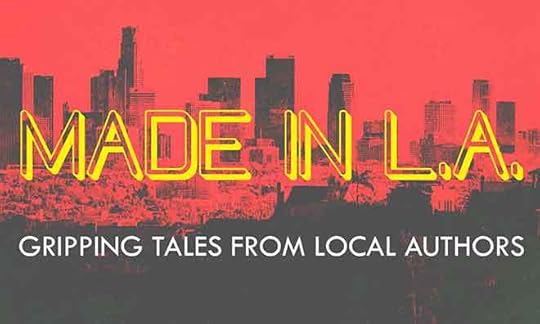
A bit of background: Writing my first novel, Broken Mirror, took three years from start to finish. During that time I participated in critique groups, writing workshops, and conferences whenever I had the time and money. As the novel neared publication, I had productive and indispensable collaborations with editors and cover artists. To build my platform, I developed an email newsletter and lobbed comments back and forth across the interwebs, clicking like, love, and retweet the way one might repetitively finger prayer beads while waiting for a miracle.
But that whole time I felt like a fraud because I wasn’t yet what I desperately wanted to be: a published author. I believe this is a common feeling among writers, especially those just starting out. The world of publishing can seem like a daunting landscape of fortress walls—submission requirements, editorial judgments, and unreturned emails—which seem intended to keep out the dregs.
At that stage, I wasn’t entirely sure that I wasn’t the dregs.
Then I published Broken Mirror, felt a thrill from making a few sales—people were actually buying and reading my book!—look a review!—and then I watched with growing dread as sales slowed to a trickle. I realized that marketing is a train that never stops and never slows, and I had to find a way to climb aboard.
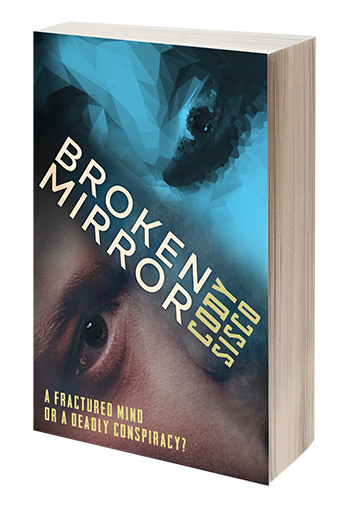
Marketing isn’t intuitive to me. It’s beyond my comfort zone. And it seems hopeless: as loud as I can shout, I’m just one voice in a rumbling, inchoate chorus of writers looking to reach a fragmented audience.
We were all doomed to obscurity, is how it seemed to me at the time.
Then, while I was writing my second novel, a wonderful thing happened that completely changed my attitude. It happened thanks to Indie Author Day 2016.
A quick run-down of the process: I signed up as a potential speaker/panelist on the Indie Author Day website. It’s easy and you can do it here by filling out the Author Inquiry form.
FILL OUT THE AUTHOR INQUIRY FORM
Not long after, the events manager at a local library invited me to their Indie Author Day event, where I met a dozen or so other indies. Suddenly the future looked brighter, friendlier, and more collegial.
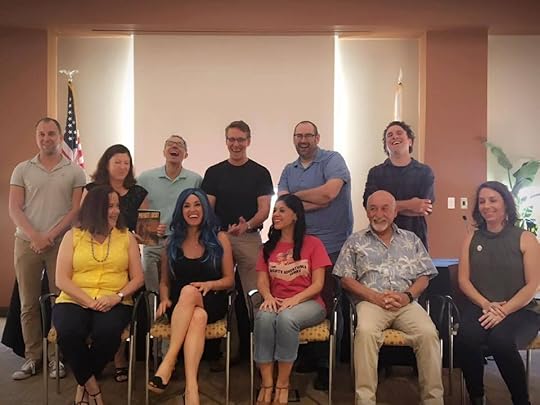
I kept in contact with a few of them via social media, we met once or twice in real life, and we continued to go about our separate ways.
Then a bright idea hit me: the Los Angeles Festival of Books was coming up. What if local indie authors banded together to share a booth? We could establish a beachhead on the shores of traditional publishing-dominated events and plant our flag. What might it say? It could read, “We’re here, we’re indie, and we’ve got books that fans are going to love,” but that wouldn’t fit on the banner…so we went with Allison Rose’s suggestion of “Made in L.A.: Gripping Stories from Local Authors.”
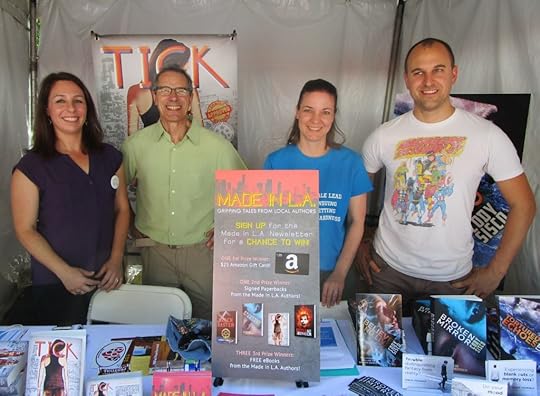
The preparations went relatively smoothly. We divvied up tasks such as creating a website (www.madeinlawriters.com), printing postcards, gathering prizes for a contest that would net us the beginnings of an email newsletter subscriber base, and more. Individually, we worked on getting posters, bookmarks, and other components to display in the booth.
But during the course of these preparations, it became clear that we were embarking on an effort that would extend beyond a single event: without much forethought, our little ad hoc group shifted in the direction of an author collective.
Over two days at the LA Times Festival of Books, we chatted with hundreds of book lovers who stopped by our booth. We talked about our writing, sold books, and described our nascent author collective. Many were intrigued: were we local writers or were our stories based in L.A.? We learned without a doubt that there’s a market for L.A.-based stories. In addition, we received much encouragement from readers as well as interest from writers who were attracted to the concept.
Several authors asked whether we accepted submissions. One literally shoved his manuscript into my hands, which I returned with a stern, “I’m not going to read it.” He then said I was bad at marketing. From his perspective, I’m sure that’s how it looked: I wasn’t doing a good job marketing his writing. J Be prepared to deal with many book lovers and with some characters that appear to have leapt from the pages of an engaging novel.
While the Made in L.A. booth was ongoing, we also heard from a few writers who were pinning their hopes on finding an agent. I have to say, it felt great to tell them our story and to encourage them to explore the indie route.
If the message isn’t clear yet, let me underline it for you now: collaborating with other authors is preferable to working alone. It extends your reach and capabilities, it provides support and pushes you more quickly toward your goals. But don’t take my word for it: I asked my fellow authors about their experience and what wisdom they would pass to other authors thinking about banding together.
WHAT WAS THE HIGHLIGHT OF THE EXPERIENCE?
Dario Ciriello
“Interacting directly with large numbers of readers and seeing how they approach a print book which interests them–which cover designs attract them, whether they only read the blurb or open the book and read the opening lines, or even flip through it to scan other passages.”
Gabi Lorino
“I wore a shirt describing what I like to write, and got a compliment on it from someone I didn’t even know. That is helping me to imagine what else I can present to people that will connect them to my stories.”
WHAT DID YOU TAKE AWAY FROM THE FESTIVAL?
Allison Rose
“It was amazing to see the diversity of people interested in my work, and even more fascinating to discover why. During my time in the booth at the L.A. Festival of Books, I learned I was selling myself short by making assumptions about who would be interested in my work. It was not until I stopped talking about myself and my book specifically that I understood it is not genre, story, or even theme that will get someone interested, but rather those small threads that connect my story to the individual. The biggest thrill of the weekend was to witness a person brighten with excitement when they realized there was something in my book they could relate to.”
WHAT ADVICE WOULD YOU GIVE OTHER AUTHORS ABOUT DOING IN PERSON EVENTS, BOOK FAIRS, CONS, ETC.?
Dario Ciriello
“Greet people early, but let them take their time to browse without interruption.”
Allison Rose
“You are there to promote your work, but you are also there to connect with people. Don’t be a sales person; be a conversation starter.”
END NOTE
The Made in L.A. indie author collective debuted at the Los Angeles Festival of Books, and we are just getting started. Stay up-to-date on our journey via our newsletter: http://madeinlawriters.com/contact/
ABOUT CODY SISCO
Cody Sisco is the author of speculative fiction that straddles the divide between plausible and extraordinary. Tortured Echoes is his second novel and continues the series that began in Broken Mirror, which focuses on Victor Eastmore’s journeys on Resonant Earth and beyond. An avid reader of Frank Herbert, Haruki Murakami, and Kim Stanley Robinson, Sisco strives to create worlds that sit in the “uncanny valley”—discomfortingly odd yet familiar, where morality is not clear-cut, technology bestows blessings and curses, and outsiders struggle to find their niche. He is a co-organizer of the Northeast Los Angeles Writers critique group and a founder of the Made in L.A. author cooperative.
Learn more at: www.codysisco.com
June 8, 2018
Broken Mirror is Featured by PublishDrive during #LGBT Pride Month
Read an LGBT book this #pridemonth. Why not Broken Mirror by @codysisco? It has been featured on Queer Sci-Fi, a website that’s all about LGBT characters in genre fiction and that is dedicated to promoting the inclusion of LGBT characters in these genres. https://t.co/wXbLOlZBGc pic.twitter.com/foQCAKrd7p
— PublishDrive (@publishdrive) June 8, 2018
March 13, 2018
A Podcast to Signal Boost Broken Mirror
For the first time ever, I was interviewed via podcast by the science fiction and fantasy superfans over at the Skiffy and Fanty Show.
During the conversation, we talked about writing characters with a mental illness, the importance of place and setting in my fiction, and much more. Marko Kloos, author of Points of Impact, was also interviewed in the same episode.
Show Notes:
Marko Kloos (00:53 – 16:26)
Marko on Twitter
Marko’s Website
“Frontlines is an action-packed military sci-fi series that captures the essence of warfare” by Andrew Liptak
Cody Sisco (16:39 – 30:54)
Cody’s Website
Cody on Twitter
Resonant Earth Series
January 23, 2018
A Fantastic 2017: Cody Sisco’s Annual Publishing Retrospective
For me, 2017 was all about dissonance. So many things I hold dear have come under attack. And yet at the same time my career flourished.
I’m learning to not be ashamed when I have good news to share and that being a writer at this time in history means I have an obligation to speak out. Mainly I do this through my fiction by raising questions about how our world could be different. In addition, I aim to share my writing journey with my fans.
Below is a brief rundown of 2017 from a very personal perspective.
But first, since so many of you are fans of the fantastical, check out this deal featuring authors piercing the veil to see what lies beyond.
#1 My Indie Author Journey
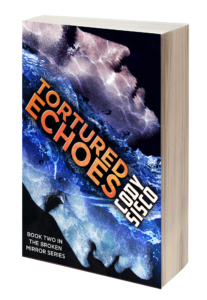 This year saw a pretty significant milestone in my writing career: the publication of my second novel, Tortured Echoes. It’s the second in my literary sci-fi series set on Resonant Earth, which is variously categorized as cyberpunk, alternate history, LGBT sci-fi, and/or utopian. It follows the adventures of a mentally ill young man who believes his grandfather was murdered.
This year saw a pretty significant milestone in my writing career: the publication of my second novel, Tortured Echoes. It’s the second in my literary sci-fi series set on Resonant Earth, which is variously categorized as cyberpunk, alternate history, LGBT sci-fi, and/or utopian. It follows the adventures of a mentally ill young man who believes his grandfather was murdered.
If you like challenging, thought-provoking, character-driven science fiction, you can get both books on sale through the end of the month here: www.brokenmirrorbook.com/links/
It’s been a wonderful journey to become an indie author. As of today, I’ve sold 928 copies of my books digitally and in print, which is better than average and bodes well for the future. More importantly, I’ve met so many amazing book lovers, writers, and publishing industry professionals. The generosity and gregariousness of this purportedly socially awkward community have been stunning, surprising, and so much fun.
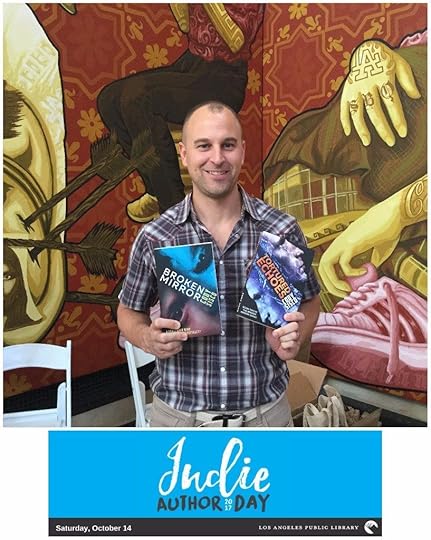
I’ll leave off with a few little-known facts: my writing has improved a lot over the years, and I consider my second book to be a better example of my craft. I’m currently working on my third novel. Once it’s finished I plan on doing a second revised edition of my first book. And then: AUDIOBOOKS!
#2 Building Writing Communities
For the past several years, I’ve been co-organizing a writing critique group called Northeast Los Angeles Writers Group (soon to change its name to Los Angeles Writers Critique Group).
The group meets three Saturdays a month in the morning. Although the nominal group membership stands at 793, we usually have between 8 and 15 writers attend each week.
Twice a month we meet in a basement-like space in a library in Pasadena with brick walls and terrible acoustics. Other times we meet in a Silver Lake library meeting room with modern lighting, 30-foot ceilings, and a whiteboard, which brings back memories of so many meetings from my consulting days at BSR.
I create and give mini-writing lessons before the critiques. This week’s lesson covers the different modes of manuscript revision and contains tips for transforming a work-in-progress.
Providing leadership to this group is a way of giving back to my community. I got my start with my writing career in this group and learned so much from the critique process, both giving and receiving. Now it’s an opportunity for me to give back and help emerging writers hone their craft and take their first steps toward publication.
Fun fact: this obligation/privilege has transformed my Friday night experience. Rather than, “go out big,” Jay and I will usually visit our local wine bar then settle in for sleep at home before “the kids these days” have started getting ready for “da club.”
www.lawriterscritiquegroup.com
#3 Finding a Tribe (of Writers)
This is a fun and true story of following my gut and having everything turn out marvelously. I couldn’t have plotted it better.
In October 2016, I participated in Indie Author Day at a library in the LA suburbs. The event was not very well attended, but it was my first time running an author booth and I met some great writers, so I tallied it as a success. I was so jazzed, the next day I signed up for a booth at the Los Angeles Times Festival of Books, at a significant expense and with little planning.
Panic began to set in. I feared I would be at a booth all by my lonesome for two days, watching thousands of readers pass by as they shunned me for being one of those weird loner writers.
To try to fix my predicament, I started conversations with the writers I had met and nudged them toward sharing the booth with me. Eventually, they agreed and we did do the event together. Better yet, in the process, as we got to know each other better, we figured out that we get along well, take a similar approach to our writing and publishing efforts, and we could do more together.

Thus was born the Made in L.A. indie author co-op (www.madeinlawriters.com). These are writers I fully endorse and would gladly do a dozen favors for and then ask them what else they need from me.
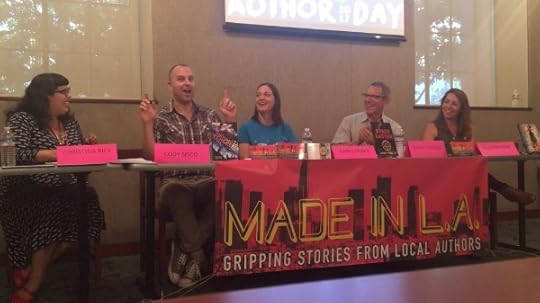
I’m very pleased to be able to recommend these authors and their books to you. You should check them out now because you’ll be hearing more about them from me for years to come.
Allison Rose
Allison is a novelist and screenwriter from Los Angeles. Tick, the first in her young adult science fiction series, tackles themes of mental illness, artistry and violence. It will be followed by Vice, part two of the Tick Series. While Rose’s stories vary in genre, her focus centers on the struggles of complex female characters.
Dario Ciriello
Dario is a professional author, freelance editor, and writing coach. Dario’s fiction titles include Sutherland’s Rules, Black Easter, and Free Verse and Other Stories. His bittersweet travel memoir, Aegean Dream, was an Amazon UK category bestseller. His writing guide, Drown the Cat, is now available in digital and print editions.
Gabi Lorino
Gabi writes comedies starring socially awkward women who occasionally interact with men. Her tales are based on her 20+ years in the dating world and hilarious stories told by friends and sisters. Gabi is a proud member of Generation X, and she’s heard more than once that her characters “act a bit younger than they are” and maybe “need an attitude adjustment,” which makes her love them even more! A Magical Time Called Later is her first ebook and is Book One of the Socially Awkward Series.
Links to their books and social media outposts can be found at www.madeinlawriters.com.
#4 The Future of Publishing (Up-and-Coming Talent)
This summer, I was privileged to join the inaugural class of the Los Angeles Review of Books (LARB) / University of Southern California Publishing Workshop.
Over five weeks, my fellow Fellows and I heard from over seventy speakers about the future of the publishing industry and worked on group projects (more on that tomorrow). This was a fantastic opportunity to supercharge my writing and publishing career for which I’m very grateful.
If you know someone who might be interested in applying to the 2018 workshop, send them here to learn more: https://thepublishingworkshop.com
If you would like to support future fellows, you can help fund scholarships here: https://thepublishingworkshop.com/donate/
Following the workshop, I helped evaluate the results of the program via an alumni survey and I’m now helping LARB part-time with alumni affairs. My aim is to foster an active, connected, and supportive alumni community. Among other things, I put together a bi-weekly job listings email and organize virtual and in-person meetups.
You can help these amazing folks network and forge their own publishing paths!
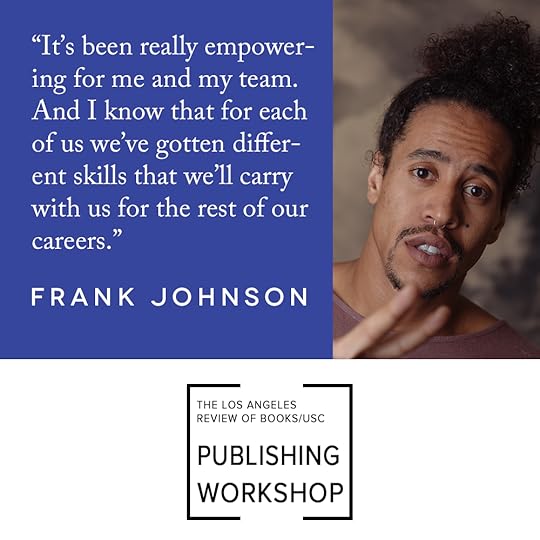
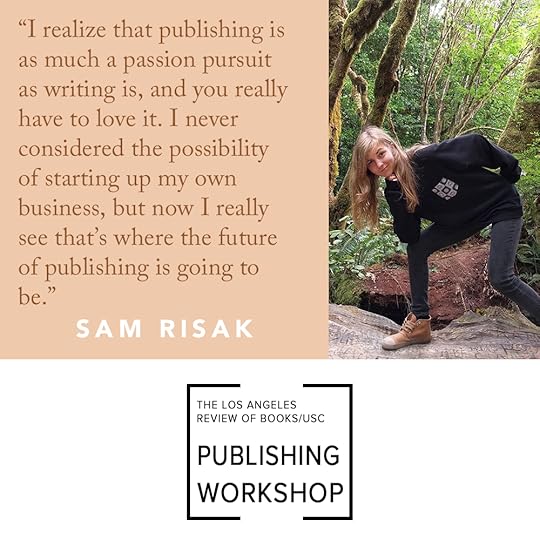
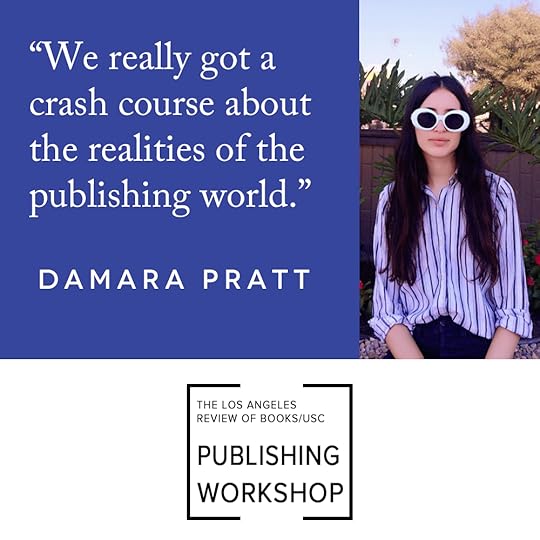
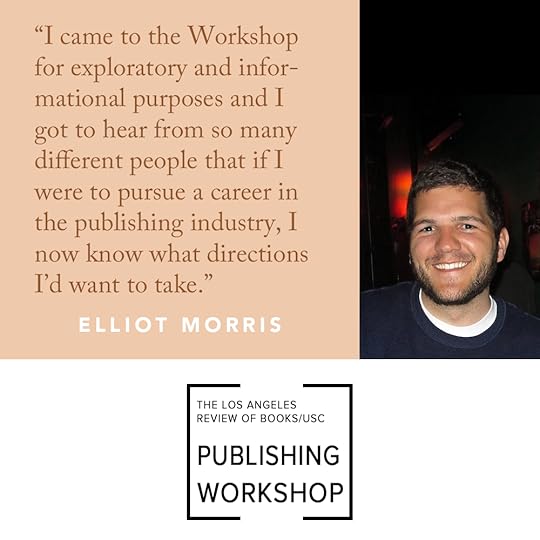
If you know of open positions or freelance opportunities related to any of the following areas, especially related to arts and entertainment, please get in touch at mailto:cody@lareviewofbooks.org
writing, editing, and publishing (print and/or digital)
social media management
podcast production and interviewing
project coordination and administration
events management
anything that requires intelligent, organized, passionate dedication from the next generation of writers and publishers
#5 Building a Literary (and Literate) Culture
I started a business!
The idea grew out of both the Made in L.A. writers and LA Review of Books Publishing Workshop discussions I was having this summer.
My company’s name is BookSwell LLC.
The long-term goal of BookSwell is to make literary culture in L.A. accessible to a mass audience. Before BookSwell, you’d have to hunt pretty hard to find out what’s happening in the book scene.
Now all the events are listed in one place and someday, hopefully soon, it’ll be host to all the context someone would need to be an informed audience member at any literary event.
So how am I going to do this? For the moment, I compile a comprehensive calendar of author appearances at bookstores and festivals at www.bookswell.club, and I send out daily and weekly newsletters to keep readers informed of their favorite author appearances.
Going forward I’m looking to partner with authors, bookstores, publishers, literary organizations, and publicists to reach out and build audiences around IRL and virtual author events.
In contrast to some similar services, I don’t discriminate when it comes to genre or draw arbitrary lines around what’s considered “literary.” Every book has an audience just waiting to find it.
If you live in L.A. or visit often and you’d like to stay informed, you can sign up at https://www.bookswell.club/subscribe/ or simply visit the events calendar whenever you wish at https://www.bookswell.club/events/
The Resonant Earth Saga
Available online or order them by name from your favorite indie bookstore.
Have Cody appear at your book club! Contact him here.
December 22, 2017
An Interview in Alternate History Fiction #3
Recently I had the pleasure of being interviewed for Issue 3 of AHF Magazine (Alternate History Fiction).
An excerpt from interview appears below. The full interview appears on the AHF website. You can get a copy of the AHF magazine here.
How long have you been writing?
I was seven when I used my parents’ electric typewriter to write a two-page portal fantasy involving a magic mirror. In college, I wrote a hideously stereotypical play about a gay painter, I started a novel about a rhinoceros prince who doesn’t want to inherit the throne, and I wrote many, many poems. There was a decade-long hiatus until 2013 when I started writing what became the Resonant Earth series.
What is the earliest work of yours that you have published or intend to publish?
There’s a poem called “Modern Love” still lurking on the Internet that was published in 1999 back when web search was new, before smartphones and social media. Literary magazines associated with San Francisco State University published several of my poems. At some point, I may revisit the rhinoceros prince story.
Who were the earliest authors to be an inspiration for your writing?
Lewis Carroll, C.S. Lewis, J.R.R. Tolkien, Marion Zimmer Bradley, and Anne McCaffrey were all early favorites. In my teens, I couldn’t get enough of Stephen King, Clive Barker, as well as the “golden age of sci-fi” canon, including Isaac Asimov, E. E. “Doc” Smith, and Arthur C. Clarke.
Which other authors do you consider to be an inspiration and for what reason?
Kim Stanley Robinson shapes exquisitely detailed worlds and populates them with characters that aren’t cardboard cutouts; they feel real, mysterious, and complicated like real people. Each of his books has had a lasting effect on me. Because of his works, I’m not content to write a cookie-cutter, paint-by-numbers kind of story. It has to challenge me and it has to challenge the reader, while still being enjoyable.
Are you inspired by any landscapes or buildings, or even towns and cities?
I spend a lot of time imagining and thinking about the built environment my characters inhabit and how they experience the natural world. I went so far as to create simulated cities of the major locales; some even made their way into the books as prefatory maps.
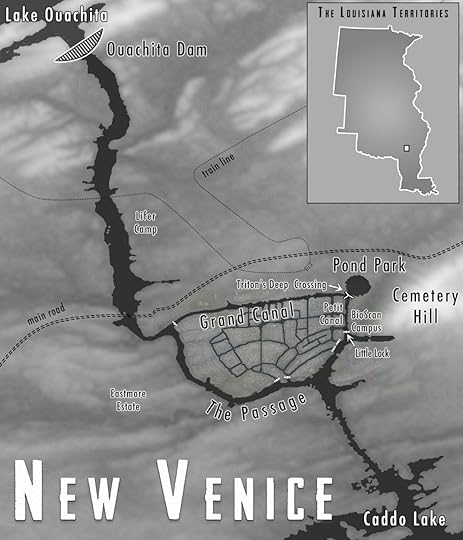
This map blends a USGS topology file, a screencap from Cities: Skylines (a city simulator), and original artwork and typsetting.
Which was the first book you published and why?
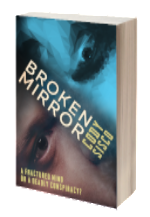 Writing Broken Mirror helped me grapple with the tragedies of how mental illness and addiction play out in our society. My cousin suffered from schizophrenia and died in an institution. So many people I went to school with saw their lives cut short or wasted. I wanted to uncover my own feelings and beliefs, especially a sort of countervailing thread about the medicalization of neurodiversity, through the course of the novel.
Writing Broken Mirror helped me grapple with the tragedies of how mental illness and addiction play out in our society. My cousin suffered from schizophrenia and died in an institution. So many people I went to school with saw their lives cut short or wasted. I wanted to uncover my own feelings and beliefs, especially a sort of countervailing thread about the medicalization of neurodiversity, through the course of the novel.


